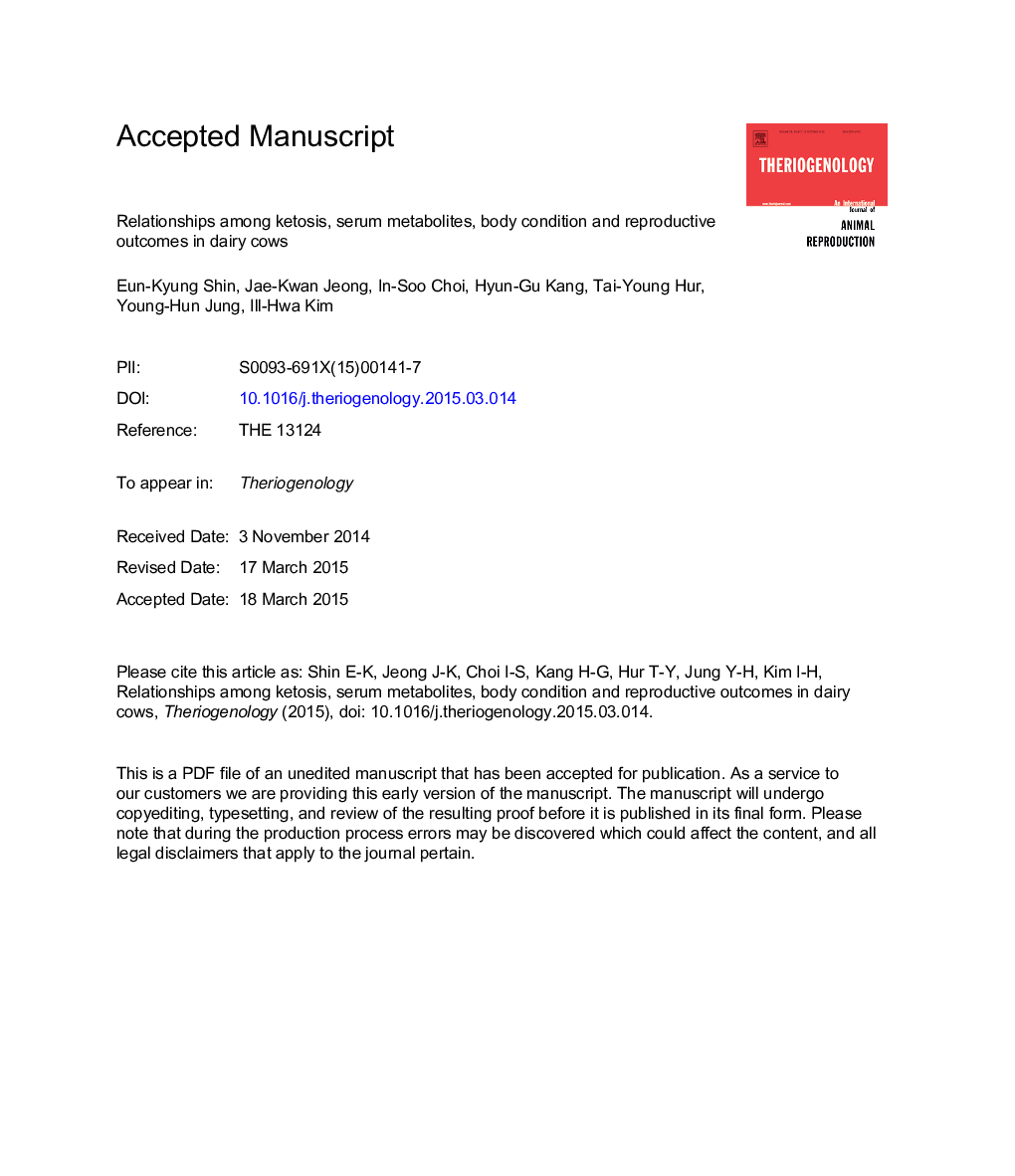| کد مقاله | کد نشریه | سال انتشار | مقاله انگلیسی | نسخه تمام متن |
|---|---|---|---|---|
| 10891872 | 1082072 | 2015 | 35 صفحه PDF | دانلود رایگان |
عنوان انگلیسی مقاله ISI
Relationships among ketosis, serum metabolites, body condition, and reproductive outcomes in dairy cows
ترجمه فارسی عنوان
ارتباط بین کتوز، متابولیت های سرم، وضعیت بدن و نتایج تولید مثل در گاوهای شیری
دانلود مقاله + سفارش ترجمه
دانلود مقاله ISI انگلیسی
رایگان برای ایرانیان
کلمات کلیدی
کتوز، متابولیت سرم، نمره وضعیت بدن، نتیجه تولید مثل، گاوهای شیری،
موضوعات مرتبط
علوم زیستی و بیوفناوری
علوم کشاورزی و بیولوژیک
علوم دامی و جانورشناسی
چکیده انگلیسی
We determined the relationships among ketosis, serum metabolites, body condition, and reproductive disorders and performance in dairy cows. Blood samples from 213 dairy cows were collected at 4 and 2 weeks prepartum, just after calving, and at 1, 2, 4, 6, and 8 weeks postpartum to measure serum β-hydroxybutyrate, nonesterified fatty acids (NEFAs), glucose, total cholesterol, urea nitrogen, aspartate aminotransferase, γ-glutamyltransferase, and progesterone concentrations. Cows were grouped on the basis of the β-hydroxybutyrate concentration at 1 and/or 2 weeks postpartum into two groups: the ketotic group (â¥1200 μmol/L, n = 59) and the nonketotic group (<1200 μmol/L, n = 154). The body condition score (BCS) was assessed simultaneously with blood collection. Clinical endometritis was diagnosed by observation of vaginal discharges (>50% pus), and subclinical endometritis was diagnosed by evaluation of uterine cytology (>18% neutrophils) at 4 weeks postpartum. Ovarian cysts were diagnosed by ultrasonography, and resumption of postpartum cyclicity was evaluated by progesterone concentrations (â¥1 ng/mL) at 4, 6, and 8 weeks postpartum. In the ketotic group, NEFA levels were higher (P â¤Â 0.0005), whereas glucose (P < 0.05-0.0005) and urea nitrogen levels (P < 0.05-0.01) were lower than those in the nonketotic group during the postpartum period. Aspartate aminotransferase levels were higher (P < 0.01) in the ketotic group than those in the nonketotic group at 2 weeks postpartum. The BCS of the ketotic group was higher than the nonketotic group during the prepartum (P < 0.001) and postpartum (P < 0.05-0.001) periods. The probabilities of clinical endometritis (odds ratio = 2.55) and ovarian cysts (odds ratio = 2.80) were higher (P < 0.05) in the ketotic group than those in the nonketotic group. The hazards of resumption of postpartum cyclicity by 8 weeks postpartum (hazard ratio = 0.67) and pregnancy by 360 days postpartum (hazard ratio = 0.68) were lower (P < 0.05) in the ketotic group. In conclusion, a higher BCS during prepartum and postpartum period and increased NEFA and aspartate aminotransferase levels, along with decreased glucose and urea nitrogen levels during postpartum, were associated with ketosis, increased reproductive disorders, and decreased reproductive performance in dairy cows.
ناشر
Database: Elsevier - ScienceDirect (ساینس دایرکت)
Journal: Theriogenology - Volume 84, Issue 2, 15 July 2015, Pages 252-260
Journal: Theriogenology - Volume 84, Issue 2, 15 July 2015, Pages 252-260
نویسندگان
Eun-Kyung Shin, Jae-Kwan Jeong, In-Soo Choi, Hyun-Gu Kang, Tai-Young Hur, Young-Hun Jung, Ill-Hwa Kim,
